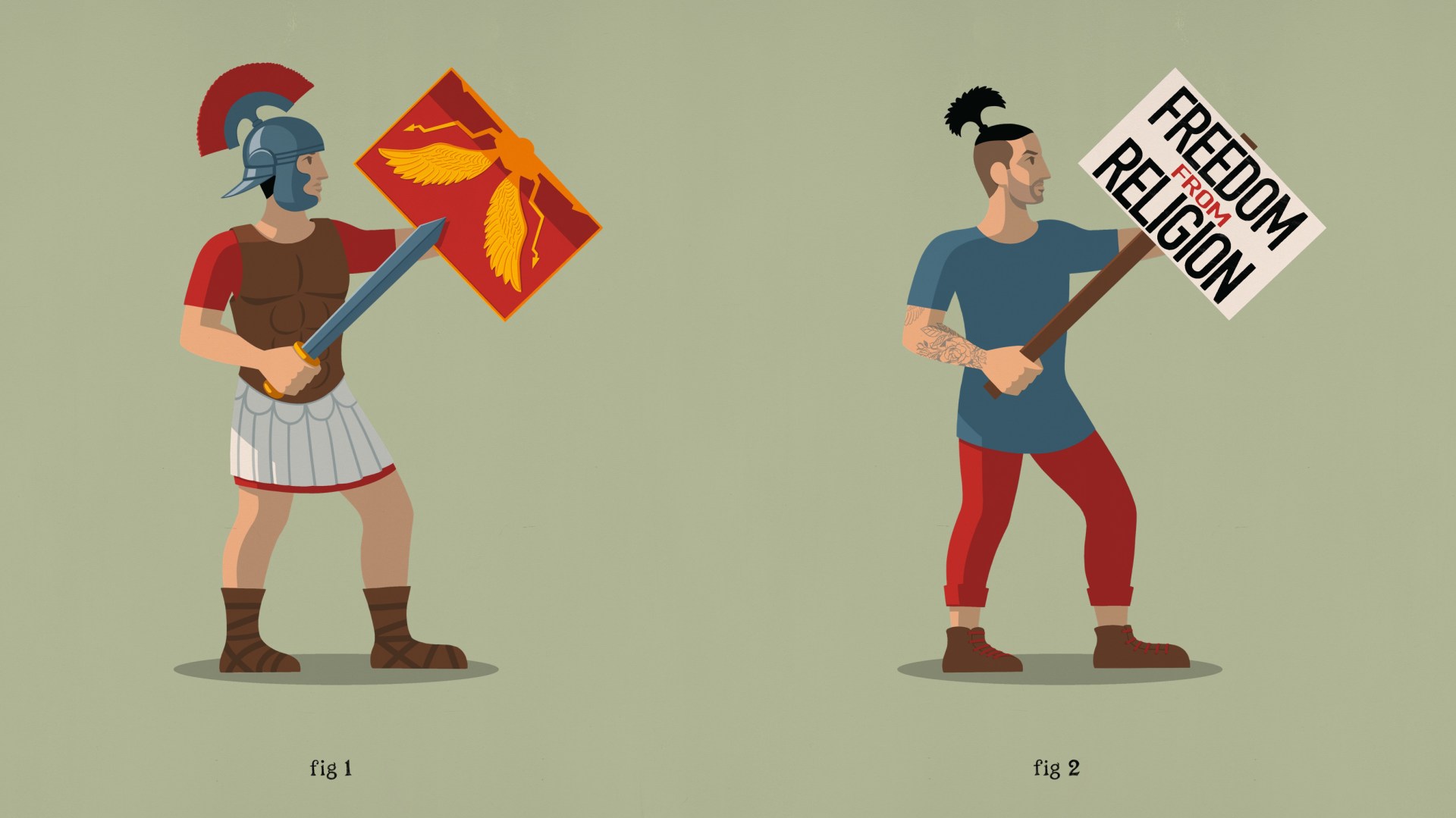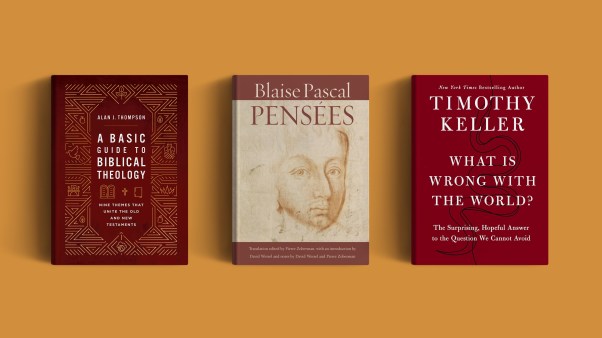In The Idea of a Christian Society (1939), T. S. Eliot saw a conflict between Christianity and paganism shaping the 20th century. Steven D. Smith’s Pagans and Christians in the City applies Eliot’s map to today’s culture wars, especially in the United States.
Pagans and Christians in the City: Culture Wars from the Tiber to the Potomac (Emory University Studies in Law and Religion (EUSLR))
Wm. B. Eerdmans
408 pages
$33.56
It’s common to portray the culture war as a battle between people who favor a public role for religion and people who want to keep religion locked securely in the private realm. Smith argues, however, that our frameworks and language obscure a deeper reality: The real fight isn’t between religion and secularism, but between two kinds of religion. His book makes the case that today’s culture war shares much in common with the culture war that rocked ancient Rome.
The Romans were pragmatic and worldly, yet they believed their greatest strength was devotion to the empire’s gods. This was evident in public rituals, architecture, the role of divination, and the military. Rome, in short, was a “city of the gods.”
The paganism of Rome treated the world itself as sacred. But Christianity introduced a radically different perspective. Christians—while affirming the world’s goodness—located the sacred in another world altogether. In other words, paganism was an immanent form of religiosity, while Christianity embraced the transcendent.
Take, for instance, their competing approaches toward sexuality. For the Romans, sex provided pleasure and progeny, but they also viewed it as a divine imperative that shared in the energy of the universe. (Some pagan religious festivals included sex shows.) Christians did not claim that sex and reproduction were wrong, though Augustine and others insisted that sexual desire in its earthly form was deeply disordered. Yet having pledged their loyalty to a different world, they thought it idolatrous to make earthly sexual fulfillment the highest good; even reproduction and family weren’t ultimate goods. Christianity demanded a degree of sexual control and renunciation that was nonsensical to many pagans.
The Romans were, in some ways, tolerant of this new transcendent religion. But over time they came to regard Christianity as incompatible with Roman values. Christians refused to pledge allegiance to the emperor. By rejecting Roman religion, Smith writes, Christians “actively and affirmatively subverted” the foundations of Roman order, the “social contract” between the empire’s gods and its people. Christians “defied and insulted the gods,” a desecration Rome could not tolerate. Christian morality, especially its sexual morality, was resented for interfering with Roman liberties.
Rome did make Christians a counter-offer: If they would be reasonable and keep their faith a private affair, they could live in peace. Christians rejected the bargain, and Roman tolerance evaporated into sporadic but bloody persecution. Christianity exposed the fact that the Romans were tolerant in theory but not in principle.
A Pagan Public Square
Smith doesn’t attempt to adjudicate historical debates about the causes of Christianity’s eventual triumph. He’s more interested in the kind of triumph Christianity achieved, and the degree to which it extinguished paganism. Christianity won in that it eventually shaped the symbols and norms that defined public life. Yet paganism persisted in art, in periodic renaissance movements, and in nostalgia for the shimmering glow of the ancient gods or resentment against Christianity’s suppression of pagan exuberance.
Modern secularism understands itself as an immanent movement that relegates religion to a purely private role. Political secularism attempts the virtually unprecedented experiment of establishing political order without reference to God or, in theory, any form of sacred. Philosophical secularism claims that rational scientific explanations of the world have made religion obsolete. If Max Weber is to be believed, we inhabit a disenchanted world.
But Smith isn’t buying it. Somewhat like Charles Taylor in A Secular Age, he sees pagan forms of religiosity popping up in surprising places. The late legal theorist Ronald Dworkin, for instance, endorsed a pantheistic “religion without God,” and writers like Sam Harris and Barbara Ehrenreich advocate modes of re-enchantment.
In two chapters about “counterrevolution,” Smith examines the internal tensions of contemporary American law, sexuality, and religious freedom. Why, for instance, are Christian symbols purged from public spaces while “sacred” national symbols (like the flag) are permitted? Why can we only tolerate public religious expressions that have lost their religious significance (in the view of what former Justice Sandra Day O’Connor called a “reasonable observer”)? Once they’ve won their civil rights, why can’t LGBT activists permit Christians their religious freedom?
In each area, Smith’s pagan-versus-Christian template proves more illuminating than the secular-versus-religion framing favored in most “culture war” analysis. The Constitution isn’t a battleground between secular and religious interpretations but between transcendent religion (Christianity in particular) and immanent religion. Transcendent religious expressions are excluded, but immanent religiosity is permitted.
Thus, for instance, during the 1990s, the Supreme Court abandoned “accommodation” as a justification for religious freedom. The standard of accommodation assumed the possibility of religious truth, protecting the right to “obey God rather than man” (within limits, which didn’t include polygamy). Recent religious liberty decisions instead pay homage to the individual conscience while treating any symbols that still imply transcendence or accountability to God, like “under God” in the Pledge of Allegiance, as constitutionally suspect.
In example after example, Smith shows that Eliot was right. We don’t have a naked public square. We have a pagan public square from which transcendent appeals and symbols, even implicit ones, are excluded.
The Scandal of Particularity
Smith’s book is strongest in the final chapters, where he writes about his specialties, constitutional law and religious freedom. His pagan-versus-Christian framework uncovers a logic behind the apparently arbitrary court decisions of recent decades.
But weaknesses crop us as he skims the surface of many centuries. He doesn’t always clarify the difference between pagan persistence and pagan revival, and he doesn’t attend sufficiently to the various ways Christianity has transformed paganism by assimilating many of its dominant ideas and symbols. (Thomas Aquinas, for instance, drew heavily on philosophical frameworks inherited from Aristotle, and a great deal of Christian art has incorporated pagan imagery.) Smith tends to treat paganism as an unchanging essence, which prevents him from doing justice to Taylor’s insight that our secular age has produced fresh forms of religious life and experience, neither strictly pagan nor strictly Christian.
But the most fundamental problem with Smith’s book is his shaky deployment of the terms immanent and transcendent. Christianity, he says, is transcendent, in that it locates human fulfillment in a world beyond “this world,” while paganism is an immanent religiosity that seeks fulfillment in the here-and-now.
The terms are misleading at best. For pagans, the human world is marred by mortality, while the gods are immortals who transcend this vale of tears. Olympus is beyond this world, where the gods feast on ambrosia. On the other hand, “transcendence” is hardly the whole story for Christianity, which affirms that the Creator took frail flesh to live a human life and die a human death. It was the unthinkable immanence of the Christian God that posed a stumbling block for pagans, as well as for early Christian heretics.
Along similar lines, treating Christianity as “transcendent” obscures the inherently socio-political character of Christianity; that is, it fails to do justice to the church. One of Christianity’s prime novelties was the formation of a new kind of social body—similar to Judaism but not ethnically defined, universal as the empire but entirely independent of it, a polis that was not confined to a single location, a this-worldly communion that also encompassed the heavenly assembly.
Treating Christianity as an instance of a more general category, like “transcendence,” doesn’t capture its novelty. It glosses over Jesus, the message of the gospel, and the formation of a church. Smudging these specifics, Smith’s framework stumbles over the scandal of particularity.
Why does Smith rely on the distinction between immanent and transcendent religion, given these historical and theological problems? In The Idea of a Christian Society, Eliot distinguished between concrete forms of religion—paganism versus Christianity. That better describes the conflict in the US, where the representatives of “transcendent religion” are overwhelmingly Christian. Why not just say so?
Two answers occur to me. First, Smith’s inclusive terminology is more legally and politically viable. To argue for the legitimacy of public Christian symbols runs afoul of contemporary constitutional interpretation. In a political environment more pluralistic than Eliot’s, the generic category enables Smith to make common cause with adherents of other “transcendent” religions.
Second, the inclusive language deflects the worry that Smith might be arguing for a specifically Christian political order. He claims that “modern Christian society would be open to transcendence,” but without sponsoring “any official account of what transcendence is and requires.”
That sounds like the classical liberal settlement regarding religion: Religions, including transcendent ones, have a robust place in the public square, but no religious truth-claims set the rules of the game. But—if I’ve decoded Smith’s hints accurately—this runs contrary to his historical analysis. American religious liberty, Smith shows, is an outgrowth of a specific religion, not generic transcendence. We can’t wish away the necessity of ground rules, which inescapably assume and imply certain beliefs about God and his relevance (or irrelevance) to politics. They assume either that Jesus is, or is not, Lord.
The polity Smith appears to imagine is literally utopian: It has existed nowhere. For all Christendom’s limitations and flaws, the same cannot be said of the idea of a Christian society.
Peter Leithart is president of the Theopolis Institute in Birmingham, Alabama. He recently authored a two-volume commentary on Revelation for the International Theological Commentary series (T&T Clark).
Do you agree? Is this missing something? Share your feedback here.











